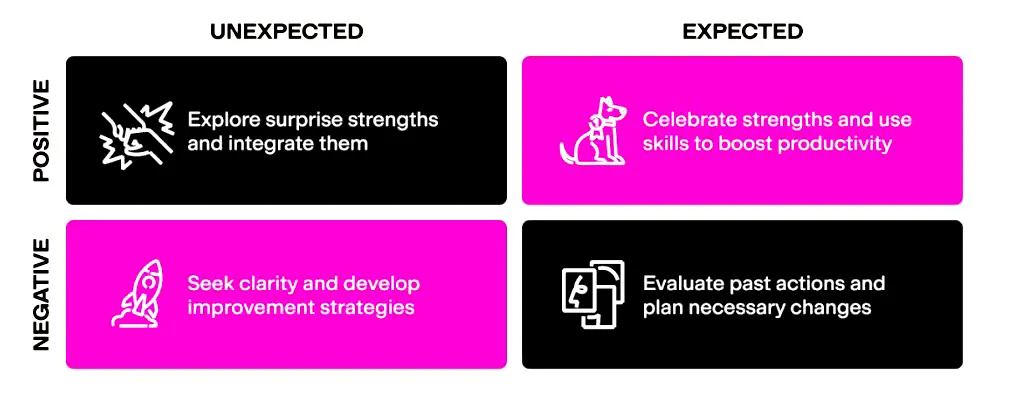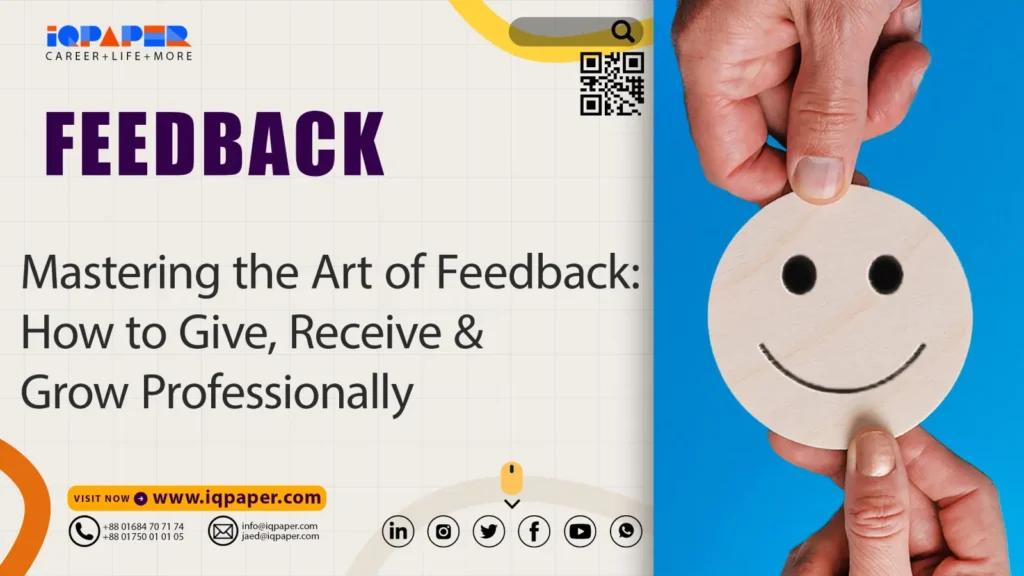70% of the employees state that they are not getting feedback to advance their career. Yet, feedback happens around us daily—in meetings, emails, casual conversations—but it often goes unnoticed or misunderstood. Why? Because most of us haven’t learned how to give or receive feedback effectively. We also confuse feedback with evaluation, though they serve different purposes. Evaluation is judgment-based, whereas feedback is a formative assessment tool that uses descriptive, constructive, and nonjudgmental language.
Feedback is fuel for growth. Exceptional leaders give powerful feedback—precise, thoughtful, and timely—because they understand its impact. When delivered effectively, feedback doesn’t just improve performance; it strengthens relationships, builds trust, and fosters a culture of continuous improvement.
Why Feedback Matters
Your feedback culture defines your growth. A strong feedback culture:
- Encourages personal and professional development
- Strengthens team relationships
- Promotes open communication
- Reduces misunderstandings and repetition of mistakes
As a leader or coach, knowing how to give and receive feedback is essential. Constructive suggestions help others grow, succeed, and feel valued.
Insights from Research
🔹 68% of employees say coaching and developmental feedback positively impact their performance.
🔹 71% rate their organizations positively when managers are trained to provide feedback. (McKinsey & Company)
Harvard’s top 5 tips to give effective feedback
Lead with empathy : Put yourself in their shoes and consider their perspectives before giving feedback.
Prepare well: Always strategise your approach before delivering feedback, considering the individual’s personality, past performance, and responsiveness.
Be specific & impactful: Focus on specific behaviors when providing feedback, identifying the root cause, starting the impact. and connecting it to consequences.
Encourage open dialogue: Incorporate enquiry into feedback sessions, asking employees about their perspective and ensuring they understand the feedback.
Embrace a forward-looking mindset: Once feedback is delivered, shift focus to the future, emphasizing how the recipient can change their behavior.
How To Give Feedback
Build rapport first
- Take a sincere interest in their life first.
- Strengthen your connection before the agenda.
Make it their meeting, not yours
- Listen intently and offer genuine support.
- It’s about them, not yours.
Choose a distraction-free environment
- Find a quiet and private space to meet.
- Consider offsite meetings for fewer interruptions.
Listen with your full presence
- Put away your devices and really focus.
- Make them feel heard and understood.
Ask their needs
- Repeatedly ask “What do you expect from me?”
- Find out how you can best support them.
Offer specific and actionable feedback
- Include strong and concrete examples.
- Give them the clear next steps.
Use the ‘Feedback Sandwich’
- Share positive feedback on both starting and ending.
- In the middle section, share the improvement areas.
- “I really appreciate how you…; It will be better if you …; Overall great work on …
Co-create meaningful goals
- Involve themselves in the goal setting process.
- Encourage them to share their own aspirations and ambitions.
How To Receive Feedback
- Listen to the given feedback: Listen to the feedback without interruptions. Effective listening will help you to absorb more information. Don’t be defensive.
- Be aware of your responses: Your body language, voice tone, gestures may make the sender uncomfortable to share the honest feedback. Rather you show that you value what others say of you.
- Stay open: Be receptive to new ideas and different opinions. You may learn a lot from the other’s opposite viewpoint.
- Dive into the message: Try to understand and feel the message, specially before responding. Find out the actual meaning and ask questions for further clarification. Repeat the key points to interpret correctly.
- Reflect and Decide: Assess the value of the feedback, find the actionable points and define the work plan. Your response is your choice. If you disagree, you may ask for a second opinion.
- Follow up: Implement the suggested steps in the feedback or you may sit with the sender with your revised actions for another feedback.
Feedback Models
SBI Model
Highly actionable and straightforward. Good for performance improvement.
Situation: Explain the situation to set the context. “During yesterday’s team meeting.”
Behaviour: Specify the observed behaviour. “I noticed you interrupted a few times.”
Impact: Share the impact of the behaviour. “Which disrupts the audience.”
Tips: Focus on behaviors, not personalities. Avoid assumptions or interpretations. Stick to what you observed.
COIN Model
Designed for constructive dialogue and actionable follow-ups.
Context: Establish the setting and background. “Great work on the last project.”
Observation: Highlight the observed specific actions. “Your provided details was…”
Impact: Explain the outcomes and impacts. “… which impressed the client.”
Next Step: Identify the future actions where both agreed. “Use that approach in future.”
Tips: Use this model to recognize successes and areas of improvement. Always include actionable next steps to drive progress.
GROW Model
A coaching framework to inspire solutions and forward momentum.
Goals: Define the agreed goal. “You want to develop your leadership skills.”
Reality: Assess the current situation and obstacles. “Currently you are managing a small team.”
Options: Brainstorm to find out potential options or paths. “You may consider leadership training.”
Will: Commit to a clear plan for nest actions. “You’ll enroll next month.”
Tips: Use open-ended questions to prompt exploration. Let them take ownership of their development path.
CEDAR Model
This model is to comprehensive deep-dive. It’s useful for complex issues.
Context: When and where the behaviour occurred. “This year your leadership on project x …”
Examples: Specific instances of what happened. “Your handling of x project was exceptional.”
Diagnosis: Your interpretation of the situation. “You’ve put extra effort on the project.”
Action: Plan next steps for change or improvement. “Let’s discuss how we can manage it easily.”
Review: Agree on timeline and follow-up. “Next month we will sit and review how you are progressing.”
DESC Model
Ideal for conflict resolution, balancing professionalism with clarity.
Describe: Objectively state the situation. “I noticed the report was submitted late…”
Express: Share your feelings professionally. “…which makes me concerned about meeting deadlines.”
Specify: Clearly outline what needs to change. “Please submit reports on time moving forward.”
Consequences: Explain the potential outcomes. “This will help ensure project success and prevent delays.”
Tips: Stay calm and professional. Avoid letting emotions take over. Make expectations specific and actionable.
BOOST Model
This model used to provide feedback on positive reinforcement.
Balanced: Provide positive and constructive feedback.
Objective: Base feedback on observable facts.
Observable: Describe specific behaviors seen.
Specific: Be precise about what was done well.
Timely: Give feedback soon after the event.
Example: I could see you put a lot of effort into your presentation today. The client was impressed, particularly with your research. Your analysis made an impact.
FEED Model
This model is used for providing constructive feedback.
Facts: What was observed?
Effects: What were the effects?
Expectations: What was expected?
Development: What needs to happen?
Example: Your report was 2 days late. It caused a delay in our review process. We expect reports on time to maintain the workflow. Can we discuss how to manage your workload more effectively?
5 R’s Model
An effective method for requesting feedback from others.
Request: Proactively ask for feedback. “What did you think of how I handled today’s team discussion? What could I have done differently?”
Receive: Actively listen and clarify. “Thanks for sharing. Can you give me an example of where I could improve next time?”
Reflect: Pause to evaluate the feedback. “It sounds like I need to give everyone more time to share their thoughts before moving forward.”
Respond: Acknowledge the feedback and your next steps. “I’ll make sure to leave more space for discussion. Thanks for pointing that out.”
Resolve: Put the feedback into action. “I’ve started pausing after each agenda item to get input. How’s that working for the team?”
Tips: Be timely. Address feedback close to the event. Stay open-minded. Every opportunity for feedback is a chance to grow.
360-Degree Review Model
This method ensures the complete feedback as it collects from different sources. Best for career development.
- Feedback is gathered from all around you.
- It highlights your strengths and areas to improve.
- It’s a great way to guide your career growth with a broad and well-rounded perspective.
Tips: Follow these steps- self assessment, manager feedback, peer feedback, direct report feedback, customer feedback.
The Feedback Matrix
This feedback matrix can be used for teams.

1. Expected + Positive:
Celebrate wins. Build confidence.
Make strengths stronger.
2. Unexpected + Positive:
Notice hidden talents.
Help people see their unique value.
3. Expected + Negative:
Face challenges head-on.
Create clear improvement plans.
4. Unexpected + Negative:
Turn surprises into growth.
See setbacks as stepping stones.
Matrix Benefits
Balanced perspective: Encourages examination of both positive and negative aspects of feedback received.
Self-discovery: Helps uncover hidden strengths and areas for improvement through unexpected feedback.
Action-oriented: Provides a framework for developing concrete plans to leverage strengths and address weaknesses.
Applying Matrix
Self-analysis: Regularly use the matrix to process feedback and guide personal growth.
Team development: Implement the matrix in performance reviews to enhance team communication and progress.
Continuous improvement: Utilize the matrix to create actionable steps for ongoing professional development.
Feedback culture: Foster an environment where constructive feedback is valued and effectively utilized.
4 Common Myths About Feedback
Part of the reason people are so hesitant to give feedback is that there are a lot of myths out there about feedback. Here are some of the most common misconceptions and a quick explanation about why they’re simply not true.
- Feedback hurts: Feedback is going to hurt. The reality is that it will hurt more if you don’t give it. According to research cited in “Feedback: The Powerful Paradox,” 94% of feedback recipients said that corrective feedback improves their performance when it’s presented well.
- People don’t want feedback: People will be unpleasantly surprised by feedback. The reality is that only 12% of people are surprised by constructive feedback. Most seem relieved when it’s called out and they’re given the chance to improve.
- They can’t handle the truth: In fact, they are begging for it! Millennials, the next generation of leaders, expect it in real-time, and on demand.
- They’re getting enough feedback: Unfortunately, this is far from true. 60% of employees say they haven’t gotten any feedback over the past 6 months or more, and 70% say their performance and possibilities for success in their careers would have increased substantially if they had been given more feedback.
Final Thoughts
Create a safe space for both giving and receiving feedback. When people feel heard and appreciated, they go beyond expectations. Feedback is not about judgment—it’s about development, potential, and progress.
“Great feedback is not an interruption; it’s an investment.”

It’s fascinating
Really insightful article!
Interesting analysis!
Understanding volatility is key to enjoying slots!
Interesting read!
Hello